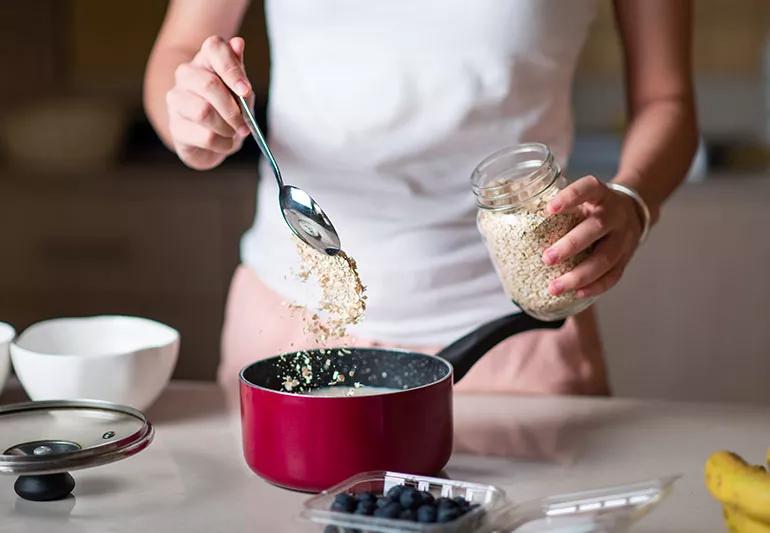Fight metabolic syndrome with heart-healthy foods

Metabolic syndrome is a serious condition. It’s a cluster of factors that put you at risk of heart disease, stroke and Type 2 diabetes.
Advertisement
Cleveland Clinic is a non-profit academic medical center. Advertising on our site helps support our mission. We do not endorse non-Cleveland Clinic products or services. Policy
But you can turn it around by making some changes to your eating habits, says dietitian Melissa Matteo, MS, RD, LD, CDE. “Changing how you eat can make a real difference in controlling metabolic syndrome.”
According to the American Heart Association, a person has metabolic syndrome if they have three or more of these factors:
The good news: Adopting healthier eating habits can influence each of those factors.
Overhauling your diet might sound intimidating. But you don’t have to go extreme. As a first step, Matteo recommends focusing on what unhelpful foods you can phase out. These include:
Advertisement
Once you’ve deep-sixed the processed stuff, you can start building meals around heart-healthy alternatives. “There’s no specific metabolic syndrome diet,” Matteo says. “Focus on whole, plant-based foods.”
She suggests checking out the Mediterranean diet, which is rich in fruits, vegetables, seafood and olive oil. Research has linked this eating style to weight loss and a lower risk of heart attacks, strokes and Type 2 diabetes.
A healthy balanced diet should include:
“Add more veggies — especially non-starchy vegetables like salad greens, broccoli and peppers,” Matteo says. When you do choose starchy vegetables, opt for those that are higher in fiber, such as beans, lentils and chickpeas.
Fruits are a good source of vitamins and minerals. Yes, they also have sugar, but those natural sugars are offset by the fiber found in whole fresh or frozen fruit. “Because of the fiber, you digest the sugars in fruit more slowly,” Matteo says. Tasty high-fiber fruits include raspberries, blackberries and pears.
Unlike processed grains that have been stripped of nutrients, whole grains are good for heart health. Foods like whole-wheat breads, barley and oats can help you avoid weight gain and lower the risk of Type 2 diabetes.
“Omega-3 fatty acids can help increase HDL (good cholesterol) and lower LDL (bad cholesterol),” Matteo says. You’ll find them in nuts, seeds and fatty fish like salmon and mackerel.
Some people wonder if the trending “keto diet” can help treat metabolic syndrome. The answer? It depends.
The keto diet is a low-carb diet that focuses on eating fats at every meal. But research about its weight-loss effectiveness is mixed. Matteo says a big drawback is that most people find it hard to keep up this way of eating for the long haul.
“Do you see yourself still eating this way in a year, five or 10? If the answer is no, I don’t encourage this method,” she says. “If you do plan to eat this way for the rest of your life, I’d still recommend avoiding saturated fats and cured meats.”
Cutting out sugar-sweetened beverages is a really important step if you have metabolic syndrome. But what about diet soda?
Some research has linked sugar substitutes in diet soda to weight gain and a variety of health problems. But the connection isn’t entirely clear.
“Diet soda gets a lot of bad press in the media, but it’s not so black and white,” Matteo says. “I definitely don’t recommend drinking a lot of it. But if it helps you wean yourself off of sugar-sweetened drinks, I think it’s ok to drink in moderation … but water is still the beverage of choice.”
Advertisement
Changing your eating habits can be challenging, but you don’t have to do it overnight. “Start with baby steps,” Matteo says. “Identify one small positive change you can make first.”
She offers these tips for getting started:
Advertisement
Learn more about our editorial process.
Advertisement

It depends on factors like your age, activity level and if you want to maintain, lose or gain weight

Avocados, cheese and nuts are high in calories but have big health benefits

Calorie counts on nutrition labels can be off by up to 20%

Focus on your body’s metabolic set point by eating healthy foods, making exercise a part of your routine and reducing stress

Calorie reduction can do more than just help you lose weight — it can also lower age-related inflammation

Your metabolism may torch 1,300 to 2,000 calories daily with no activity

Consuming fewer calories than your body burns is a ‘calorie deficit’ that can lead to weight loss

Understand how your body creates energy to take your fitness to the next level

The best parenting style balances enforcing rules and showing plenty of love

Tips include cutting back on sugar, focusing on exercise and managing stress

It can be harder to let go when you’ve invested time, energy and emotions — but it might be the healthier choice long term